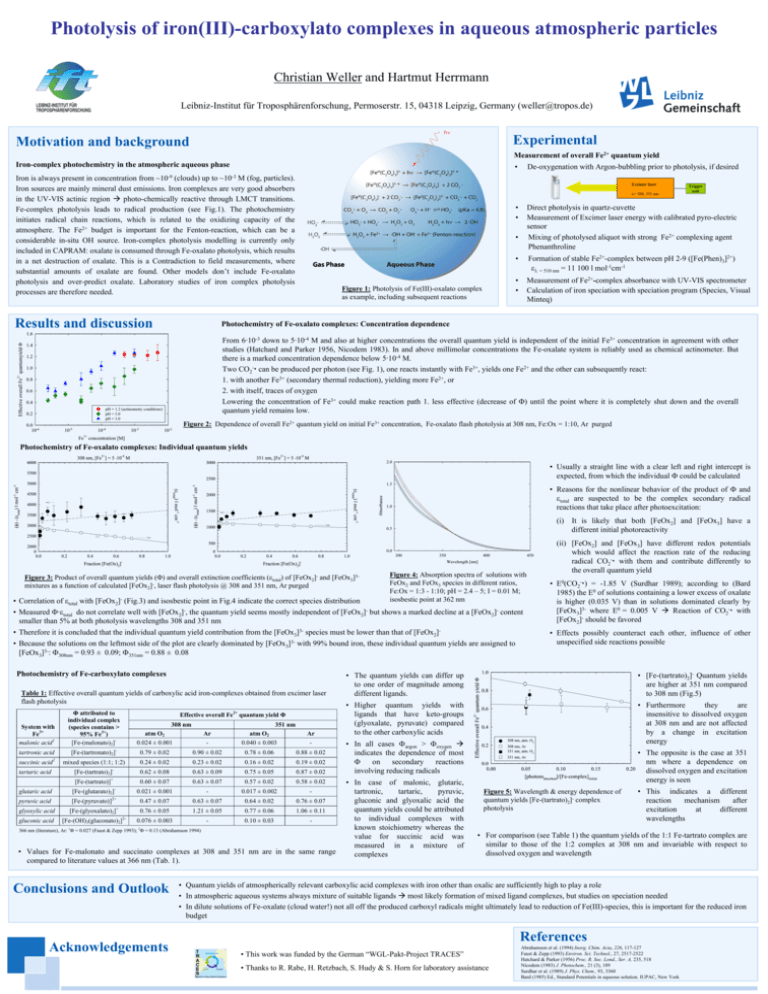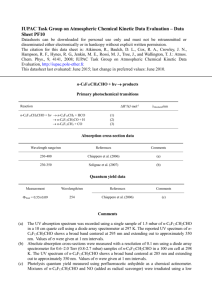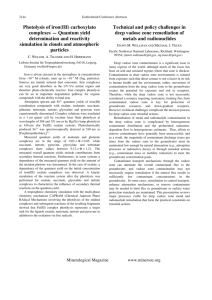Photolysis of iron(III)-carboxylato complexes in aqueous
advertisement

Photolysis of iron(III)-carboxylato complexes in aqueous atmospheric particles Christian Weller and Hartmut Herrmann Leibniz-Institut für Troposphärenforschung, Permoserstr. 15, 04318 Leipzig, Germany (weller@tropos.de) LEIBNIZ-INSTITUT FÜR TROPOSPHÄRENFORSCHUNG Experimental Motivation and background Measurement of overall Fe2+ quantum yield Iron-complex photochemistry in the atmospheric aqueous phase • Iron is always present in concentration from ~10-9 (clouds) up to ~10-3 M (fog, particles). Iron sources are mainly mineral dust emissions. Iron complexes are very good absorbers in the UV-VIS actinic region Æ photo-chemically reactive through LMCT transitions. Fe-complex photolysis leads to radical production (see Fig.1). The photochemistry initiates radical chain reactions, which is related to the oxidizing capacity of the atmosphere. The Fe2+ budget is important for the Fenton-reaction, which can be a considerable in-situ OH source. Iron-complex photolysis modelling is currently only included in CAPRAM: oxalate is consumed through Fe-oxalato photolysis, which results in a net destruction of oxalate. This is a Contradiction to field measurements, where substantial amounts of oxalate are found. Other models don’t include Fe-oxalato photolysis and over-predict oxalate. Laboratory studies of iron complex photolysis processes are therefore needed. Results and discussion De-oxygenation with Argon-bubbling prior to photolysis, if desired Excimer laser λ= 308, 351 nm • • Direct photolysis in quartz-cuvette Measurement of Excimer laser energy with calibrated pyro-electric sensor Mixing of photolysed aliquot with strong Fe2+ complexing agent Phenanthroline • Figure 1: Photolysis of Fe(III)-oxalato complex as example, including subsequent reactions Trigger unit • Formation of stable Fe2+-complex between pH 2-9 ([Fe(Phen)3]2+) ελ = 510 nm = 11 100 l mol-1cm-1 • • Measurement of Fe2+-complex absorbance with UV-VIS spectrometer Calculation of iron speciation with speciation program (Species, Visual Minteq) Photochemistry of Fe-oxalato complexes: Concentration dependence From 6·10-3 down to 5·10-4 M and also at higher concentrations the overall quantum yield is independent of the initial Fe3+ concentration in agreement with other studies (Hatchard and Parker 1956, Nicodem 1983). In and above millimolar concentrations the Fe-oxalate system is reliably used as chemical actinometer. But there is a marked concentration dependence below 5·10-4 M. Two CO2-x can be produced per photon (see Fig. 1), one reacts instantly with Fe3+, yields one Fe2+ and the other can subsequently react: 1. with another Fe3+ (secondary thermal reduction), yielding more Fe2+, or 2. with itself, traces of oxygen Lowering the concentration of Fe3+ could make reaction path 1. less effective (decrease of Φ) until the point where it is completely shut down and the overall quantum yield remains low. Figure 2: Dependence of overall Fe2+ quantum yield on initial Fe3+ concentration, Fe-oxalato flash photolysis at 308 nm, Fe:Ox = 1:10, Ar purged Photochemistry of Fe-oxalato complexes: Individual quantum yields • Usually a straight line with a clear left and right intercept is expected, from which the individual Φ could be calculated • Reasons for the nonlinear behavior of the product of Φ and εtotal are suspected to be the complex secondary radical reactions that take place after photoexcitation: (i) It is likely that both [FeOx2] and [FeOx3] have a different initial photoreactivity Figure 3: Product of overall quantum yields (Φ) and overall extinction coefficients (εtotal) of [FeOx2]- and [FeOx3]3mixtures as a function of calculated [FeOx2]-, laser flash photolysis @ 308 and 351 nm, Ar purged • Correlation of εtotal with [FeOx2]- (Fig.3) and isosbestic point in Fig.4 indicate the correct species distribution Figure 4: Absorption spectra of solutions with FeOx2 and FeOx3 species in different ratios, Fe:Ox = 1:3 - 1:10; pH = 2.4 – 5; I = 0.01 M; isosbestic point at 362 nm • Measured Φ·εtotal do not correlate well with [FeOx2]-, the quantum yield seems mostly independent of [FeOx2]- but shows a marked decline at a [FeOx2]- content smaller than 5% at both photolysis wavelengths 308 and 351 nm • Therefore it is concluded that the individual quantum yield contribution from the [FeOx3]3- species must be lower than that of [FeOx2]• Because the solutions on the leftmost side of the plot are clearly dominated by [FeOx3]3- with 99% bound iron, these individual quantum yields are assigned to [FeOx3]3-: Φ308nm = 0.93 ± 0.09; Φ351nm = 0.88 ± 0.08 Photochemistry of Fe-carboxylato complexes Table 1: Effective overall quantum yields of carboxylic acid iron-complexes obtained from excimer laser flash photolysis System with Fe3+ malonic acid1 Φ attributed to individual complex (species contains > 95% Fe3+) [Fe-(malonato)2]- atm O2 0.024 ± 0.001 Ar - atm O2 0.040 ± 0.003 Ar - tartronic acid [Fe-(tartronato)2]- 0.79 ± 0.02 0.90 ± 0.02 0.78 ± 0.06 0.88 ± 0.02 succinic acid2 mixed species (1:1; 1:2) 0.24 ± 0.02 0.23 ± 0.02 0.16 ± 0.02 0.19 ± 0.02 tartaric acid [Fe-(tartrato)2]- 0.62 ± 0.08 0.63 ± 0.09 0.75 ± 0.05 0.87 ± 0.02 [Fe-(tartrato)]+ 0.60 ± 0.07 0.63 ± 0.07 0.57 ± 0.02 0.58 ± 0.02 glutaric acid [Fe-(glutarato)2]- 0.021 ± 0.001 - 0.017 ± 0.002 - pyruvic acid [Fe-(pyruvato)]2+ 0.47 ± 0.07 0.63 ± 0.07 0.64 ± 0.02 0.76 ± 0.07 glyoxylic acid [Fe-(glyoxalato)2]+ 0.76 ± 0.05 1.21 ± 0.05 0.77 ± 0.06 1.06 ± 0.11 gluconic acid [Fe-(OH)3(gluconato)2]2- 0.076 ± 0.003 - 0.10 ± 0.03 - Effective overall Fe2+ quantum yield Φ 308 nm 351 nm 366 nm (literature), Ar: 1Φ = 0.027 (Faust & Zepp 1993); 2Φ = 0.13 (Abrahamson 1994) • Values for Fe-malonato and succinato complexes at 308 and 351 nm are in the same range compared to literature values at 366 nm (Tab. 1). Conclusions and Outlook Acknowledgements (ii) [FeOx2] and [FeOx3] have different redox potentials which would affect the reaction rate of the reducing radical CO2-x with them and contribute differently to the overall quantum yield • E0(CO2-x) = -1.85 V (Surdhar 1989); according to (Bard 1985) the E0 of solutions containing a lower excess of oxalate is higher (0.035 V) than in solutions dominated clearly by [FeOx3]3- where E0 = 0.005 V Æ Reaction of CO2-x with [FeOx2]- should be favored • Effects possibly counteract each other, influence of other unspecified side reactions possible • The quantum yields can differ up to one order of magnitude among different ligands. • [Fe-(tartrato)2]- Quantum yields are higher at 351 nm compared to 308 nm (Fig.5) • Higher quantum yields with ligands that have keto-groups (glyoxalate, pyruvate) compared to the other carboxylic acids • Furthermore they are insensitive to dissolved oxygen at 308 nm and are not affected by a change in excitation energy • In all cases Φargon > Φoxygen Æ indicates the dependence of most Φ on secondary reactions involving reducing radicals • In case of malonic, glutaric, tartronic, tartaric, pyruvic, gluconic and glyoxalic acid the quantum yields could be attributed to individual complexes with known stoichiometry whereas the value for succinic acid was measured in a mixture of complexes • The opposite is the case at 351 nm where a dependence on dissolved oxygen and excitation energy is seen Figure 5: Wavelength & energy dependence of quantum yields [Fe-(tartrato)2]- complex photolysis • This indicates a different reaction mechanism after excitation at different wavelengths • For comparison (see Table 1) the quantum yields of the 1:1 Fe-tartrato complex are similar to those of the 1:2 complex at 308 nm and invariable with respect to dissolved oxygen and wavelength • Quantum yields of atmospherically relevant carboxylic acid complexes with iron other than oxalic are sufficiently high to play a role • In atmospheric aqueous systems always mixture of suitable ligands Æ most likely formation of mixed ligand complexes, but studies on speciation needed • In dilute solutions of Fe-oxalate (cloud water!) not all off the produced carboxyl radicals might ultimately lead to reduction of Fe(III)-species, this is important for the reduced iron budget References • This work was funded by the German “WGL-Pakt-Project TRACES” • Thanks to R. Rabe, H. Retzbach, S. Hudy & S. Horn for laboratory assistance Abrahamson et al. (1994) Inorg. Chim. Acta, 226, 117-127 Faust & Zepp (1993) Environ. Sci. Technol., 27, 2517-2522 Hatchard & Parker (1956) Proc. R. Soc. Lond., Ser. A, 235, 518 Nicodem (1983) J. Photochem., 21 (3), 189 Surdhar et al. (1989) J. Phys. Chem., 93, 3360 Bard (1985) Ed., Standard Potentials in aqueous solution. IUPAC, New York








